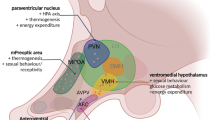Abstract
The present studies were undertaken to investigate the neuroactive steroidal modulation of feeding behavior and possible involvement of γ-aminobutyric acid type-A (GABA-A) and mitochondrial diazepam binding inhibitor (DBI) receptors (MDR) in food-deprived male mice. Allopregnanolone (0.5–2 mg/kg), a neurosteroid, progesterone (1–10 mg/kg), a neurosteroid precursor, and 4′-chlordiazepam (0.25–1 mg/kg), a specific high affinity MDR agonist, produced a dose-dependent hyperphagic effects. In contrast, neurosteroids pregnenolone sulfate (PS) (1–10 mg/kg) and dehydroepiandrosterone sulfate (DHEAS) (1–10 mg/ kg) produced a hypophagic effect, in a dose-dependent manner. The allopregnanolone-, progesterone- and 4′-chlordiazepam-induced hyperphagic effect was blocked by picrotoxin (1 mg/kg), a GABA-A chloride channel antagonist, but not by flumazenil (2 mg/kg), a benzodiazepine (BZD) antagonist. The 4′-chlordiazepam-induced hyperphagic effect was prevented by pretreatment with PK11195 (2 mg/kg), a selective partial MDR antagonist. The hypophagic effect of DHEAS (10 mg/kg) was reversed by dizocilpine (10 μg/kg), an NMDA receptor antagonist, but resistant to muscimol (0.1 mg/kg), a selective GABA-A receptor agonist. In contrast, the PS (10 mg/kg)-induced hypophagic response was resistant to dizocilpine, but sensitive to muscimol (0.1mg/kg). Both the sulfated neurosteroids PS and DHEAS also reversed the hyperphagic effect of allopregnanolone. In addition, the BZD agonist triazolam (0.05–0.25 mg/kg) also produced a flumazenil- and picrotoxin-sensitive hyperphagic effects, thereby suggesting the changes in feeding behavior by neurosteroids represent GABA-A receptor mediated hyperphagic action. Although the possible antistress or anxiolytic actions of neurosteroids may confound the hyperphagia, behavioral effects observed were specific to food because the mice were adopted to the test environment and diet, and of a possible variation between various neurosteroids in the extent to which antistress or anxiolytic effect produced at hyperphagic doses. The hyperphagic effects of progesterone and 4′-chlordiazepam resembled that of neurosteroid allopregnanolone. Therefore, the effect of progesterone may be imputed to its metabolism to allopregnanolone, while the 4′-chlordiazepam-induced hyperphagic response is related to its MDR-stimulated neurosteroidogenesis and subsequent modulation of GABA-A receptors. The hypophagic response following DHEAS may, at least partly, involve an NMDA receptor mechanism. However, PS-induced hypophagia may be mediated by GABA-A or other receptor systems. These data suggest a pivotal role for GABA-A and mitochondrial DBI receptors in the hyperphagic effects of neurosteroids and reinforces a role for endogenous neurosteroids in regulating feeding behavior. Future studies may lead to the development of neurosteroid-based anorectic/hyperphagic agents for therapeutic use.
Similar content being viewed by others
Author information
Authors and Affiliations
Additional information
Received: 30 September 1997/Final version: 18 November 1997
Rights and permissions
About this article
Cite this article
Samba Reddy, D., Kulkarni, S. The role of GABA-A and mitochondrial diazepam-binding inhibitor receptors on the effects of neurosteroids on food intake in mice. Psychopharmacology 137, 391–400 (1998). https://doi.org/10.1007/s002130050635
Issue Date:
DOI: https://doi.org/10.1007/s002130050635




